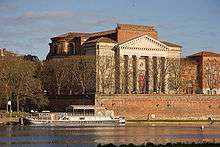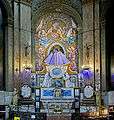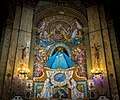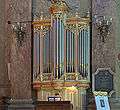Notre-Dame de la Daurade

Notre-Dame de la Daurade is a basilica in Toulouse, France. It was established in 410 when Emperor Honorius allowed the conversion of pagan temples to Christianity. The original building of Notre-Dame de la Daurade was a temple dedicated to Apollo.[1]
History
During the 6th century a church was erected, decorated with golden mosaics; the current name derives from the antique name, “Deaurata”, (Latin: aura, gold). It became a Benedictine monastery during the 9th century. After a period of decline starting in the 15th century, the basilica was demolished in 1761 to make way for the construction of Toulouse's riverside quays. The buildings were restored and a new church built, but the monastery was closed during the French Revolution, becoming a tobacco factory.
The basilica had housed the shrine of a Black Madonna. The original icon was stolen in the fifteenth century, and its first replacement was burned by Revolutionaries in 1799 on the Place du Capitole. The icon presented today is an 1807 copy of the fifteenth century Madonna. Blackened by the hosts of candles, the second Madonna has been known since the sixteenth century as Notre Dame La Noire.[2]
The current edifice was built during the 19th century.
The church has been listed as a Monument historique by the French Ministry of Culture;[3] its organ has also been classified.[4]
 Column from Notre-Dame de la Daurade, 5th century
Column from Notre-Dame de la Daurade, 5th century Seven-sided sanctuary of Notre Dame de la Daurade, with niches decorated with columns.
Seven-sided sanctuary of Notre Dame de la Daurade, with niches decorated with columns. Black Madonna of Toulouse
Black Madonna of Toulouse Black Madonna of Toulouse in her blue dress
Black Madonna of Toulouse in her blue dress Gallery organ
Gallery organ Choir organ
Choir organ Baptismal font.
Baptismal font. Baptismal font.
Baptismal font.
Notes
- ↑ Notre-Dame de la Daurade
- ↑ Vanished Kingdoms: The History of Half-Forgotten Europe, Norman Davies
- ↑ (in French) Ministry of Culture database entry for Notre-Dame-de-la-Daurade
- ↑ (in French) Ministry of Culture database entry for the Organ
Further reading
- Weitzmann, Kurt, ed., Age of spirituality: late antique and early Christian art, third to seventh century, no. 595, 1979, Metropolitan Museum of Art, New York, ISBN 9780870991790
| Wikimedia Commons has media related to Basilique Notre-Dame de la Daurade. |